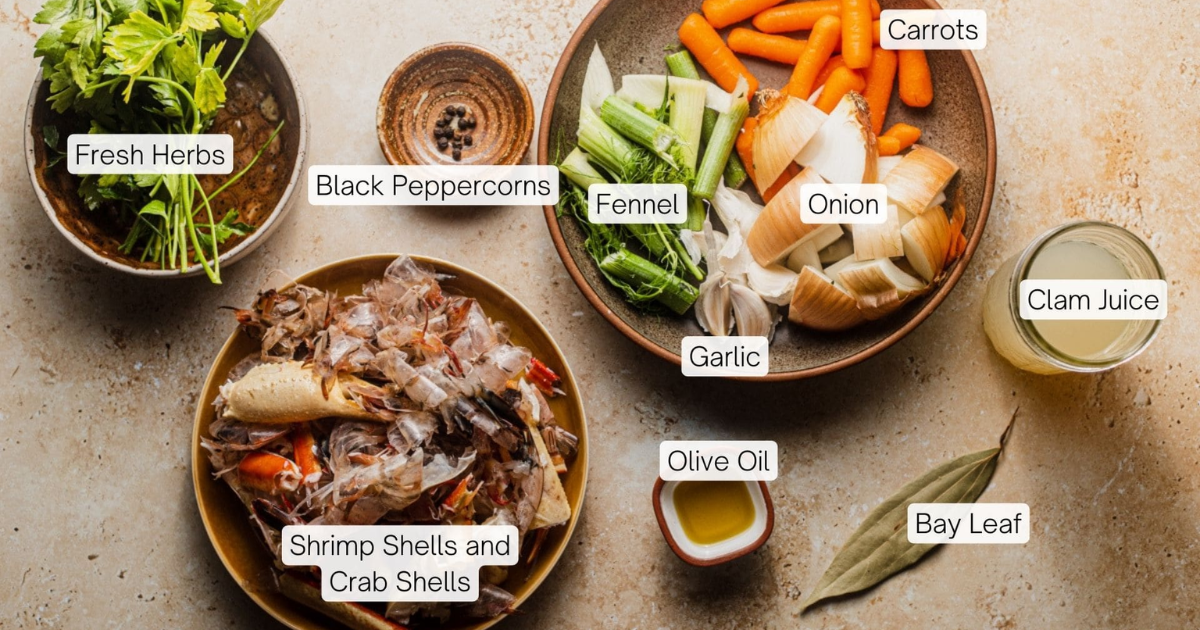Seafood stock is a rich, aromatic base that brings depth to a wide range of dishes, from chowders and bisques to risottos and seafood paellas. Making your own seafood stock is simple and cost-effective, as it primarily uses shells, fish bones, and a few aromatics to create a complex flavor profile. Here’s a step-by-step guide to making seafood stock that will elevate any seafood dish.
Why Make Your Own Seafood Stock?
Homemade seafood stock has a fresher, richer flavor than store-bought versions. It’s also a great way to make use of seafood scraps like shrimp shells, crab legs, lobster shells, and fish bones. Making seafood stock at home allows you to control the salt content and customize the flavors to suit your preferences. This versatile stock enhances soups, stews, and sauces, adding a wonderful oceanic depth to your cooking.
Ingredients for Seafood Stock
Gather these ingredients to make a flavorful seafood stock:
- Shells and bones from seafood (shrimp shells, crab shells, lobster shells, or fish bones—avoid oily fish like salmon)
- 1 large onion, chopped
- 2–3 celery stalks, chopped
- 2–3 carrots, chopped
- 3–4 garlic cloves, smashed
- 1–2 bay leaves
- Fresh herbs (a few sprigs of thyme, parsley, and/or fennel fronds)
- 8–10 cups of water
- Salt and pepper, to taste
- Optional: Lemon peel, whole black peppercorns, or a splash of white wine to add brightness
Step-by-Step Guide to Making Seafood Stock
Follow these steps to create a delicious, aromatic seafood stock that will enhance your seafood recipes.
Step 1: Prepare the Seafood Shells and Bones
After preparing your seafood (such as peeling shrimp or filleting fish), save the shells, bones, and any leftover bits. Rinse them lightly to remove any surface impurities. You’ll want about 1–2 pounds of seafood shells and bones for a deeply flavored stock.
Step 2: Sauté the Aromatics
In a large stockpot, heat a tablespoon of oil over medium heat. Add the chopped onion, celery, carrots, and garlic. Sauté for about 5–7 minutes, or until the vegetables are soft and fragrant. This step helps release the natural sweetness of the vegetables and adds depth to your stock.
Step 3: Add the Seafood Shells and Bones
Add the seafood shells and bones to the pot with the aromatics. Stir and cook for another 5–7 minutes, until the shells turn pink (if using shrimp shells) and start to release their flavor.
Step 4: Add Water and Seasonings
Pour in enough water to cover the shells and vegetables, usually about 8–10 cups. Add the bay leaves, fresh herbs, and any optional seasonings like peppercorns or lemon peel. If desired, add a splash of white wine to deepen the flavor.
Step 5: Simmer the Stock
Bring the mixture to a gentle boil, then reduce the heat to low and let it simmer. Cover the pot and allow the stock to simmer for 45 minutes to 1 hour. Avoid overcooking, as seafood stock can become bitter if simmered too long.
Pro Tip: Skim off any foam or impurities that rise to the top during the first 10–15 minutes of simmering. This will keep your stock clear and enhance the flavor.
Step 6: Strain the Stock
Once the stock has simmered and developed a rich, flavorful aroma, carefully strain it through a fine-mesh sieve or cheesecloth into a large bowl or another pot. Discard the solids (shells, bones, and vegetables).
Step 7: Cool and Store
Allow the stock to cool to room temperature before storing. Transfer it to airtight containers or freezer-safe bags. Refrigerate the stock for up to 3 days or freeze it for up to 3 months.
Pro Tip: Divide the stock into smaller portions before freezing so you can thaw only what you need for each recipe.
Tips for Making the Best Seafood Stock
- Avoid Oily Fish: Using oily fish like salmon or mackerel can create a stock with a strong, overpowering taste. Stick to mild-flavored fish bones or shellfish shells.
- Use Fresh Ingredients: Fresh shells, bones, and vegetables will create a cleaner, better-tasting stock.
- Brighten with Lemon or Wine: Adding a hint of acidity from lemon peel or white wine enhances the stock’s complexity without overpowering the seafood flavor.
How to Use Your Homemade Seafood Stock
Seafood stock is versatile and can add depth and richness to many recipes. Here are some ways to use it:
- Soups and Chowders: Use it as a base for seafood chowders, lobster bisque, clam chowder, or shrimp soup.
- Risotto: Replace chicken or vegetable stock with seafood stock in a seafood risotto for added flavor.
- Paella: Seafood stock is perfect for making a rich, flavorful paella.
- Pasta Sauces: Add seafood stock to pasta sauces to create a more cohesive seafood dish.
Gravies and Pan Sauces: Use it as a base for gravies or pan sauces to accompany seafood dishes.

Leave a Reply